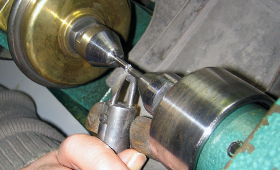Objects which sparkle like stars – training for precious stone engravers is updated
New training regulations to enter into force on 1 August
35/2018 | Bonn, 27.06.2018

Precious stones glitter in countless shapes and colours. They symbolise timelessness, wealth and power and have enthralled mankind for centuries. The task of precious stone engravers is to process the gems in their charge, bring out the true beauty of the stones and render them useful. This occupation is now to be modernised in the light of developments in the field of laser technology, changes to work and business processes and advances in processing techniques. The Federal Institute for Vocational Education and Training (BIBB) collaborated with social partners and experts from occupational practice to draw up new training regulations for the occupation of precious stone engraver on behalf of the Federal Government. These will enter into force on 1 August.
The new training regulations will replace and consolidate the three previous training occupations of precious stone engraver, precious stone cutter, and diamond cutter. Basic training in these areas exhibits a high degree of commonalty, and such instruction frequently takes place jointly. In future, the new ordinance will offer the four specialisms of “industrial diamond cutting”, “jewellery diamond cutting”, “precious stone cutting” and “precious stone engraving”.
- Industrial and jewellery diamond cutters bring great precision to bear in adding the necessary final grind to the crystallised carbon stones entrusted to their care. Because diamonds represent the hardest natural material known anywhere in the world, they use drills, knives, scalpels and the sharpest parts of electronic devices and machine tools to transform the raw diamonds into scintillating finished objects.
- Precious stone cutters perform the right finishing touches to add a characteristic shine to emeralds, rubies, sapphires and other gems and decorative stones. In order to achieve the correct form, they split the raw stones, saw them to size and use appropriate manual and machine-based techniques to carry out a series of grinding, facing and polishing operations.
- Precious stone engravers process and engrave natural and artificial precious and decorative stones. They use their artistic sensitivity to work on individual pieces or series production runs, adding features such as images, portraits, monograms, coats of arms or ciphers. They incorporate delicate details into articles of jewellery and turn gems into figures or objects. During these processes, careful attention needs to be paid to the differing characteristics of the stones and to selection of the correct tool.
Training extends over a period of three years and culminates in a final and journeyman examination conducted by the chamber of commerce and industry or chamber of crafts and trades. Depending on the specialism they adopt, precious stone engravers primarily work for gemstone and jewellery producers in the craft trades sector. They also find employment in jewellery and engraving workshops, in the larger scale jewellery manufacturing industry, at companies which produce diamond tools, at small firms in the jewellery and watch making branch, at jewellery workshops and in jeweller’s shops.
Trainees in this occupation enjoy very good prospects of subsequent permanent employment. Those who have completed training in the specialism of precious stone engraving may go on to pursue continuing training leading to the qualification of master precious stone engraver.
On 1 August 2018, the updated training regulations and the relevant aligned skeleton curriculum for the school-based section of the dual vocational education and training, which has been developed by the Standing Conference of the Ministers of Education and Cultural Affairs, will replace existing regulations from 1989 and 1992.
Image material is available at www.bibb.de/pressefotos.
Contact partner: Brigitte Seyfried
Specimen copy requested if printed